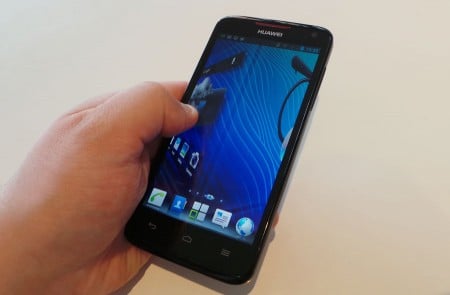Performance
Huawei has made quite a name for itself over the past few years, producing many a budget phone, but in 2012, the company has been giving the mid-range a good thwack, producing devices designed to take on flagship handsets from the big boys and offer a real bang for your buck.
In the Ascend D1 Quad, the aim is to show that a quad-core handset needn’t cost an arm and a leg, effectively giving devices like the HTC One X, Samsung Galaxy S3, and Google Nexus 4 a run for their money.
Huawei may not have the same sort of design team as Apple or Samsung, but it’s still giving it the best it can, and for the most part, it feels like an evolution of previous Huawei Ascend models.
A little thicker than the last one that came through GadgetGuy’s labs, the Ascend D1 Quad features a rubberised back that offers some resistance to fingertips, while still making it reasonably grippy.
There’s also a 720p display on offer here, sitting at the 4.5 inch screen size, lower than the 4.7, 4.8, and 5.5 inch displays we’ve seen in premium smartphones in 2012, but still big enough for most people.
From what we’ve seen of it, the screen on the D1 Quad is easily Huawei’s best screen yet, managing near perfect viewing angles from every perspective, bright colours, and a level of clarity that puts it on par with devices far beyond its price tag.
While the screen still has some reflectivity issues – what phone doesn’t? – it can be compensated by turning the screen brightness up.

For the most part, Huawei has gone with a pretty standard version of Android 4.0 “Ice Cream Sandwich,” keeping it much the way that Google has designed it and is showing it in other devices, such as the Galaxy Nexus and Motorola RAZR M, smartphones with Google’s stock editions of Android 4.0.
Huawei has made a couple of changes here with the inclusion of a homescreen replacement, and one that has a 3D interface. Here on the D1 Quad, you can choose whether you want the regular Google-designed 2D screen, or one more befitting of a future where everything is three-dimensional. We mostly stuck with the 2D one, but you can decide, going so far as to change the theme and make it look prettier.
Outside of the homescreen, most of your menu is as Google left it: scrolling left to right through the apps and widgets, the same dialpad, and even the regular settings screen.
It’s a reasonably stock experience, except with Huawei’s own processing technology found on-board, surprising given that we usually see either a Snapdragon or Tegra chip in anything not manufactured by Samsung, which has its own Exynos processor for smartphones.
That said, Huawei’s quad-core chip is actually very responsive, resulting in higher speeds than Nvidia’s Tegra 3 chip found in the HTC One X, even though this phone comes in at a price below that of HTC’s handset.

We had no problems in performance doing our regular thing, and the battery life is better than average for a quad core phone, managing a day and a half with multiple email accounts and regular updates to it, phone calls, short text messages, web surfing, the odd game, and social networking.
If you do less of this, or even had less mail running, we could easily see two days of battery life from this handset, which outperforms the batteries on other quad-core smartphones.
Some of this battery life comes at the expense of not having a replaceable battery, a first in a Huawei device, and one that might irritate some, but seems to be becoming a standard amongst brands.










Great article Leigh nice to see these kind of reviews looking forward to others.
Huawei brands seem to have the camera problem; slow shutter speed and poor quality. phone shuts down when it feels like a holiday. battery can’t last with GPS on for a full day. You have done a good attempt to break the market, Huawei. Improvize and you will get there.
Nice, but should sell for a lot less if the company wants to break into ‘any’ market outside China.
The LG Nexus 4 wth the same 8GB of memory is $150 cheaper, has Bluetooth 4.0, WiFi, 2GB ram & the latest Jelly Bean O/S. Hmm! Google may subsidise the cost, but what is the cost of manufacturing a mid range mass produced phone today anyway?